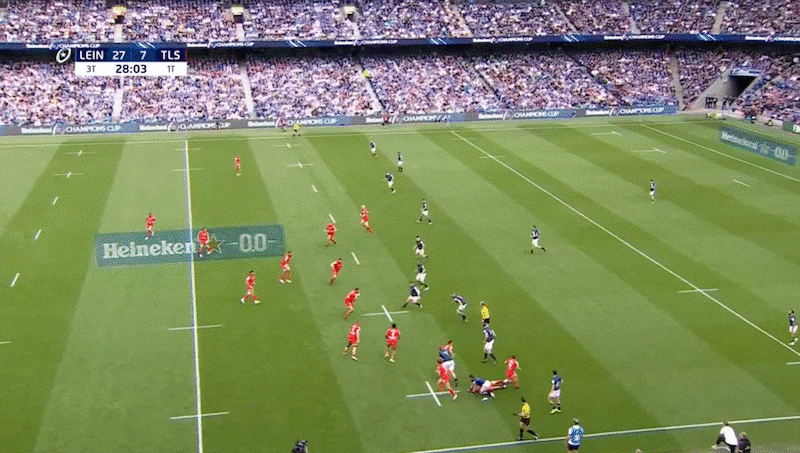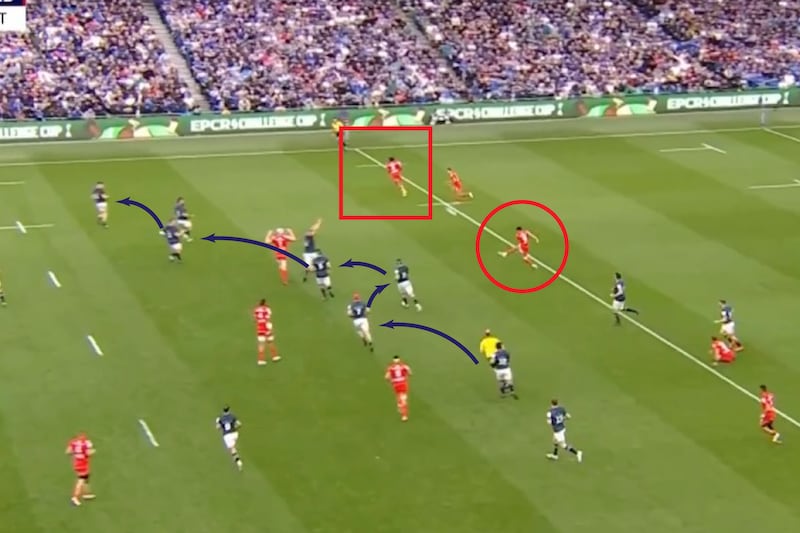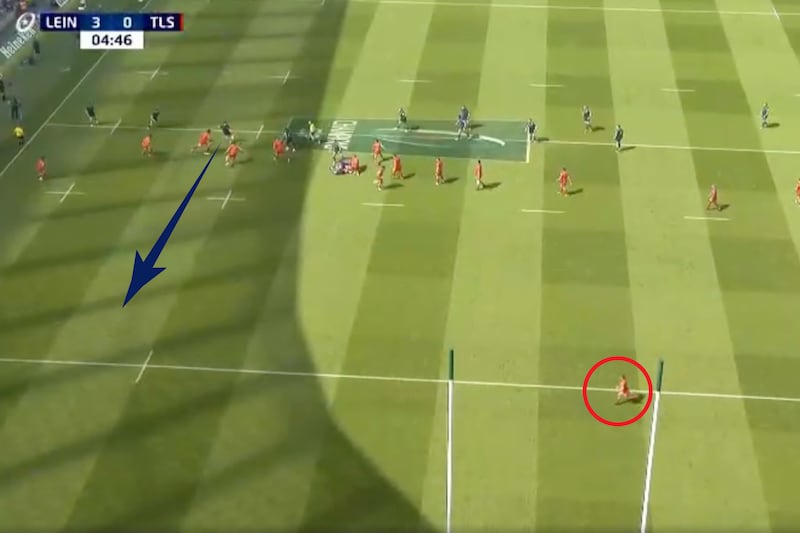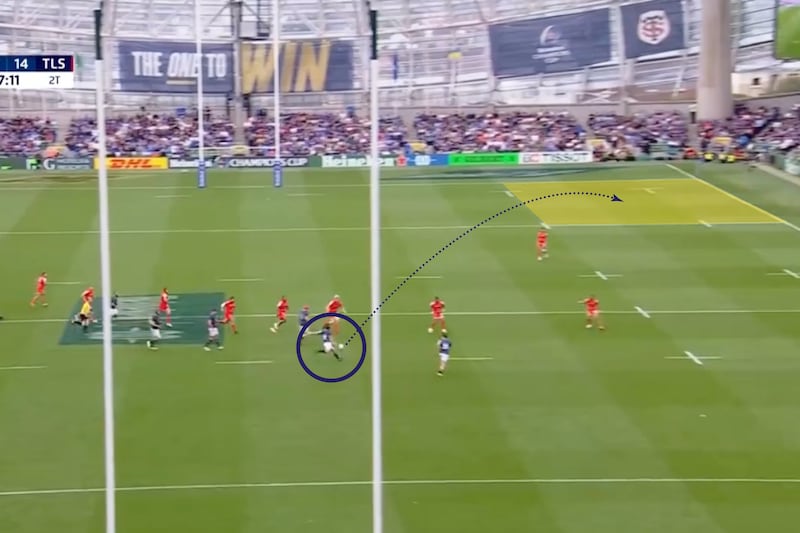For the third year in succession, Leinster meet Toulouse in a Champions Cup knockout tie. In 2022 and 2023, the Irish province prevailed at the semi-final stage, outscoring their French opponents by a combined margin of 42 points (40-17 in 2022 and 41-22 last year). For games at a late stage of a premier competition, such scorelines represent a pair of hammerings. This year, with both sides featuring plenty of the same personnel, can Leinster prove their superiority and are their tactics repeatable?
Discipline
The biggest factor in recent years was Toulouse’s shambolic discipline. The effect of a card on a match can be overstated, but that charge cannot be levied at either recent contest between these two sides. Especially last year, Toulouse imploded, handing Leinster early dominance and victory on a plate.
In 2023, Thomas Ramos saw yellow for a deliberate knock-on during a relatively innocuous Leinster attack. Rodrigue Neti followed suit for a needless headbutt when Toulouse had the ball. During the two sin bin periods, Leinster scored 28 of their 41 points. In 2022, Emmanuel Meafou also saw yellow for Toulouse.
In the first 25 minutes of last year’s contest, the French side conceded five penalties, Leinster gave away none. A year on, they coughed up three unanswered penalties in the first 15 minutes.
READ MORE
Infringements in quick succession only added to the problem. Last year, in a handful of minutes, Toulouse lost Ramos to a yellow, conceded a score off that penalty and offered Leinster another attacking platform with a needless neck roll after the restart. When Ramos came back on to the park the pressure was compounded by a handling error, an unsympathetic pass hitting Jack Willis in the face which allowed Dan Sheehan to score comically.
Be it errors or discipline, Toulouse could not stop the rot and they duly imploded, ending both contests early on.
Power outage
When they did hold on to the ball, Toulouse’s attack failed to fire. In 2023 they made more post-contact metres than Leinster (419 vs 263) but only broke the line four times to Leinster’s six. In 2022, Toulouse only made 199 post-contact metres with just a solitary line break.
How did Leinster restrict them? Toulouse’s attack relies on two main elements, the first being their heavy forward carriers charging around the corner time and again to build momentum.
Leinster competed selectively at the breakdown, opting to keep numbers in the line and push up in a controlled manner. While Toulouse’s first try in 2023 came from the defence sitting off too much, generally the tactic worked well. With defenders well set, Leinster’s forwards did concede some ground in contact, but they did not allow damaging line breaks.
Facing the bigger carriers, such as Meafou and his 145kg of ballast, Leinster either used multiple defenders to limit yardage or cut him down with chop tackles; specialist Will Connors starts on Saturday.

Meafou’s impact was limited, making no line breaks across either semi-final. His size ensured decent figures for metres made, including a try from close range in 2023, but the numbers don’t show his inability to create gaps in the line.
Transition + Kick battle
The other facet which Leinster limited was the counterattack, Toulouse’s threat on transition. With Thomas Ramos, Romain Ntamack, Antoine Dupont and now Blair Kinghorn patrolling the backfield, Toulouse’s ability in broken field running, especially when returning kicks or punishing disorganised defences on turnover ball, is elite. Sitting at a 41.4 per cent success rate, they are the eighth-best side in the world for turning breaks into tries.
Yet barring Dupont running in a try from a blocked kick in 2022, this transition threat was non-existent across against Leinster. Part of the issue was luck. While Toulouse forced 10 turnovers over the two games, most came via jackal penalties where the game stopped and allowed the defence to set; they did not get quick turnover ball which could be flung wide and kept alive.
Leinster’s kicking game also limited transition opportunities. On kick chase, connectivity in the defensive line was consistently good, meaning Ntamack et al had no gaps to counter through.

The actual kicking strategy itself was accurate. Leinster frequently found grass inside the 22 over the head of the backfield cover. Dangerous runners had to turn their backs to regather possession instead of coming on to the ball with momentum. At times, Toulouse stood too high in the backfield, leaving space in behind.

But Leinster’s kicking accuracy deserves praise, most notably when Charlie Ngatai found a sliver of space for a 50:22 last year. As well as kicking accurately, Leinster simply kicked more often than Toulouse, 64 vs 47 kicks across the two contests.

How much of this success is repeatable for Leinster? Under Sean O’Brien and then Jacques Nienaber, Leinster have drastically altered their defensive tactics. Instead of looking to control Toulouse’s carriers by staying out of the breakdown and maintaining a measured line speed, Leinster will flood the ruck and blitz. This system did prove its efficacy when limiting La Rochelle’s powerful forward carriers.
Preventing Toulouse’s transition attack will come down to similar tactics; holding on to the ball, effective rucking to limit turnovers and an accurate kicking game.
Yet the biggest historical factor, penalties and errors from the French side, surely cannot be counted on. Will they once again implode in the early stages, coughing up penalties, cards and simple scores? If they don’t, can Leinster’s tactics elsewhere keep them on top?
That question was not asked over the last two contests. A more disciplined Toulouse outfit should pose it on Saturday.
- Sign up for push alerts and have the best news, analysis and comment delivered directly to your phone
- Join The Irish Times on WhatsApp and stay up to date
- Listen to our Inside Politics podcast for the best political chat and analysis













